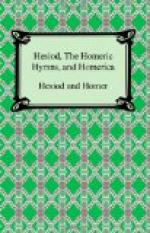The Epigrams of Homer
The “Epigrams of Homer” are derived from the pseudo-Herodotean “Life of Homer”, but many of them occur in other documents such as the “Contest of Homer and Hesiod”, or are quoted by various ancient authors. These poetic fragments clearly antedate the “Life” itself, which seems to have been so written round them as to supply appropriate occasions for their composition. Epigram iii on Midas of Larissa was otherwise attributed to Cleobulus of Lindus, one of the Seven Sages; the address to Glaucus (xi) is purely Hesiodic; xiii, according to mm. Croiset, is a fragment from a gnomic poem. Epigram xiv is a curious poem attributed on no very obvious grounds to Hesiod by Julius Pollox. In it the poet invokes Athena to protect certain potters and their craft, if they will, according to promise, give him a reward for his song; if they prove false, malignant gnomes are invoked to wreck the kiln and hurt the potters.
The Burlesque Poems
To Homer were popularly ascribed certain burlesque poems in which Aristotle ("Poetics” iv) saw the germ of comedy. Most interesting of these, were it extant, would be the “Margites”. The hero of the epic is at once sciolist and simpleton, `knowing many things, but knowing them all badly’. It is unfortunately impossible to trace the plan of the poem, which presumably detailed the adventures of this unheroic character: the metre used was a curious mixture of hexametric and iambic lines. The date of such a work cannot be high: Croiset thinks it may belong to the period of Archilochus (c. 650 B.C.), but it may well be somewhat later.
Another poem, of which we know even less, is the “Cercopes”. These Cercopes (`Monkey-Men’) were a pair of malignant dwarfs who went about the world mischief-making. Their punishment by Heracles is represented on one of the earlier metopes from Selinus. It would be idle to speculate as to the date of this work.
Finally there is the “Battle of the Frogs and Mice”. Here is told the story of the quarrel which arose between the two tribes, and how they fought, until Zeus sent crabs to break up the battle. It is a parody of the warlike epic, but has little in it that is really comic or of literary merit, except perhaps the list of quaint arms assumed by the warriors. The text of the poem is in a chaotic condition, and there are many interpolations, some of Byzantine date.
Though popularly ascribed to Homer, its real author is said by Suidas to have been Pigres, a Carian, brother of Artemisia, `wife of Mausonis’, who distinguished herself at the battle of Salamis.
Suidas is confusing the two Artemisias, but he may be right in attributing the poem to about 480 B.C.




